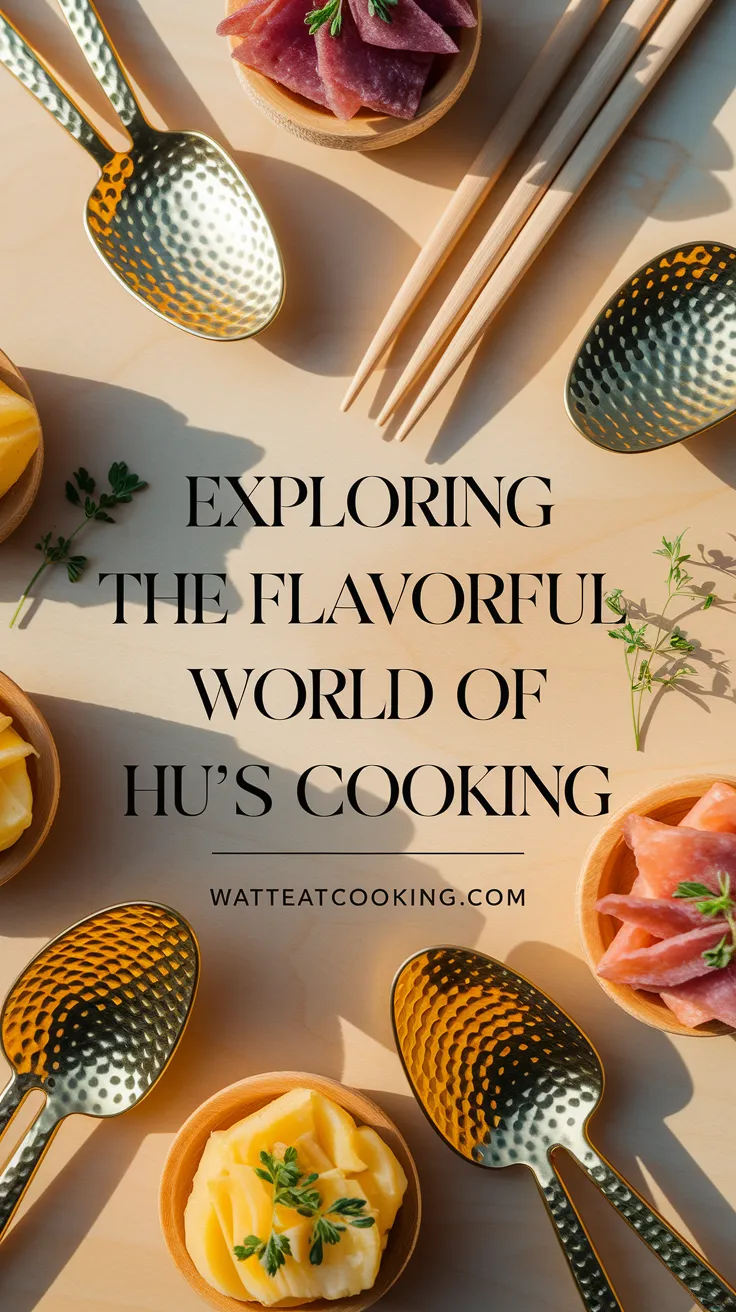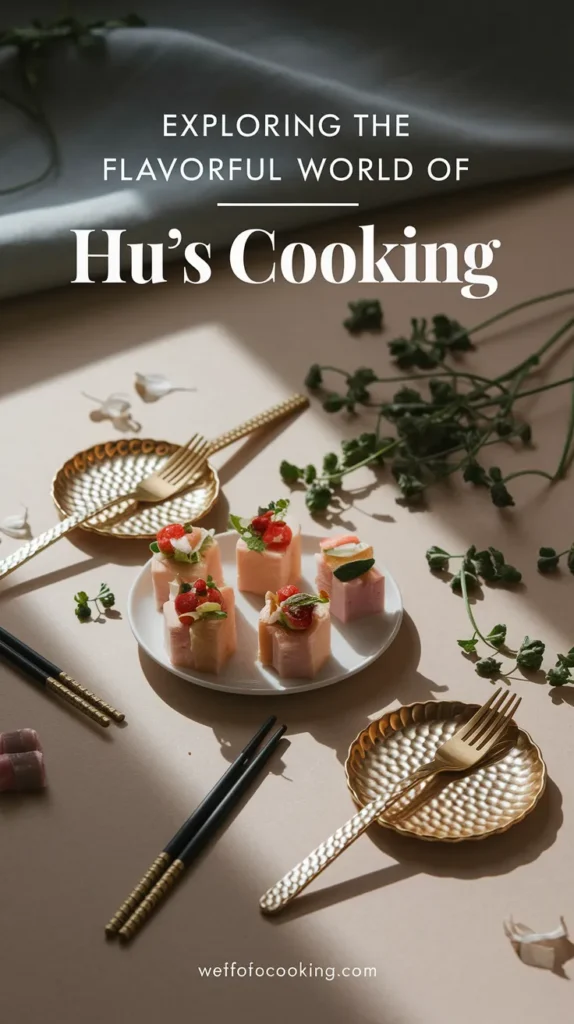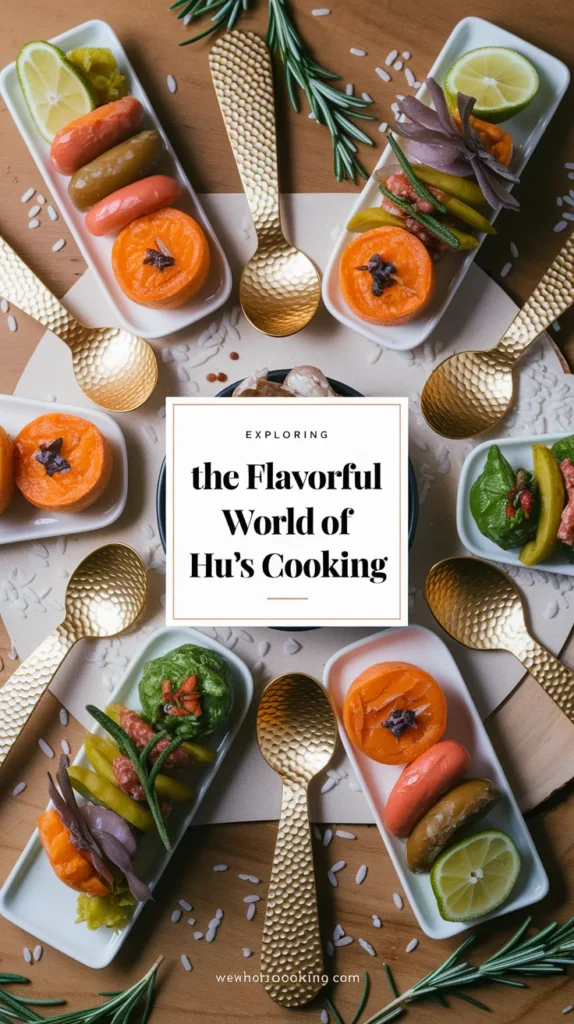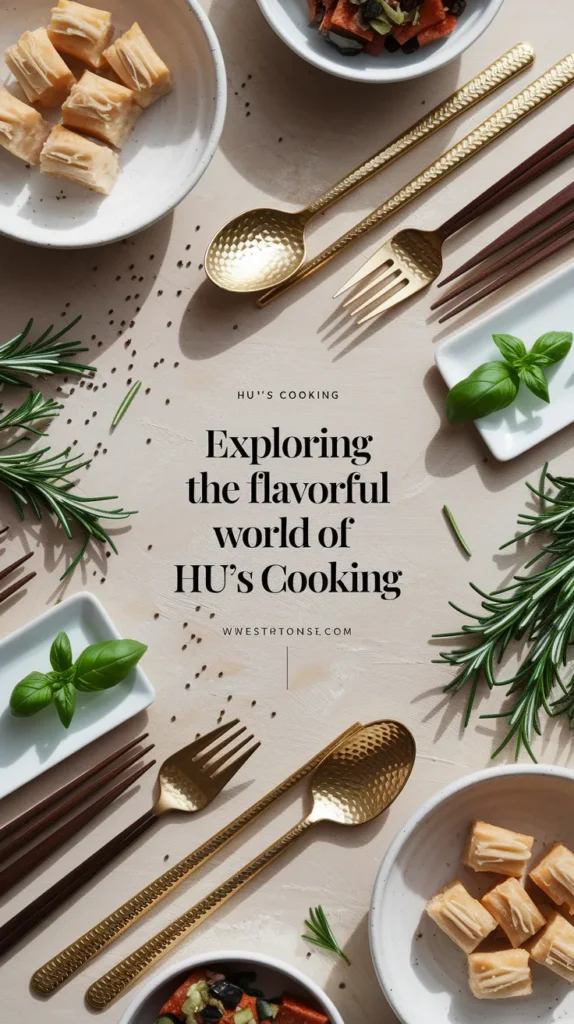Hu’s cooking invites you on a culinary journey that showcases the vibrant flavors and unique techniques rooted in various Asian cuisines. Hu’s approach to cooking focuses on fresh ingredients, bold spices, and an emphasis on balance, making every dish an opportunity to celebrate sensory experiences. You can easily dive deeper into this flavorful world with just a few simple steps in your kitchen.
One of the hallmarks of Hu’s cooking style is the use of seasonal ingredients. Fresh produce not only enhances the flavors of dishes but also promotes health and sustainability. When shopping for ingredients, consider the following:
- Local Markets: Visit local farmers’ markets for the freshest produce.
- Seasonal Selections: Choose fruits and vegetables that are in season to maximize flavor.
- Whole Ingredients: Opt for whole grains, fresh meats, and artisanal products for the best quality.
Hu’s cooking often features a variety of spices that bring each dish to life. Understanding how to use spices is essential. Here are a few crucial spices frequently found in Hu’s recipes:
- Ginger: Adds warmth and a zesty kick.
- Garlic: A universal flavor enhancer with depth.
- Chili Peppers: Provides varying levels of heat depending on your preference.
- Sesame Oil: Imparts a rich, nutty aroma to dishes.
To master the art of Hu’s cooking, it’s vital to learn some foundational recipes that you can adapt as you grow more confident in the kitchen. Here are three essential dishes that capture the essence of this culinary style:
| Dish | Main Ingredients | Cooking Technique |
|---|---|---|
| Stir-Fried Noodles | Noodles, mixed vegetables, soy sauce, ginger | Stir-frying |
| Spicy Szechuan Tofu | Tofu, garlic, chili sauce, scallions | Simmering and sautéing |
| Sweet and Sour Chicken | Chicken, bell peppers, pineapple, vinegar | Frying and baking |
When you cook with Hu’s philosophy in mind, it’s all about balance. Every dish should have a combination of sweet, salty, sour, and umami elements. Experimenting and finding the right equilibrium can make your cooking not only enjoyable but also an engaging sensory delight for all who taste your creations.
Hu’s principles can also elevate your dining experience. Making your meals memorable involves serving them creatively. Use colorful plating, thoughtfully chosen tableware, and even music to set a lively atmosphere. Here are some ideas to enhance your dining experience:
- Themed Nights: Create a dining theme—like “Szechuan Night”—where you serve several courses inspired by a single region.
- Pairing Drinks: Match your dishes with Asian-inspired beverages like sake, jasmine tea, or a refreshing lychee martini.
- Interactive Cooking: Engage your guests by involving them in cooking, such as making dumplings or sushi together.
Hu’s cooking allows you to explore a myriad of flavors and techniques that can transform everyday meals into culinary adventures. Whether you’re a beginner or a seasoned chef, embracing these elements can bring excitement to your kitchen.
For inspiration, you can check out websites like Serious Eats and Chinese Grandma. These platforms provide a wealth of recipes and cooking techniques that align beautifully with Hu’s cooking principles.
Ultimately, Hu’s cooking is not just about following a recipe; it’s about embracing the process, experimenting fearlessly, and savoring every bite. By exploring this flavorful world, you can create dishes that not only reflect cultural richness but also your personal culinary journey.
Essential Ingredients in Hu’s Kitchen
Cooking in Hu’s kitchen is a delightful blend of flavors and traditions. To create authentic dishes, it all starts with essential ingredients that elevate every meal. Understanding these ingredients can help you replicate the magic of your own cooking. Here are the key staples you need for a truly authentic experience.
Fresh Herbs and Spices
Herbs and spices are the backbone of any great kitchen. They add depth and flavor to dishes, making each bite memorable. In Hu’s kitchen, the following are non-negotiable:
- Cilantro: Fresh and fragrant, cilantro adds brightness to dishes, especially in salsas and salads.
- Garlic: Essential for building flavors, garlic can be used raw or cooked to enhance any dish.
- Ginger: This spice adds warmth and a spicy tang, perfect for stir-fries and marinades.
- Green Onions: Also known as scallions, these are perfect for garnishing and adding a mild onion flavor.
High-Quality Oils
Choosing the right cooking oil is crucial for achieving the desired flavor and texture in videos. Hu’s kitchen often relies on a few standout oils:
- Sesame Oil: This oil has a rich, nutty flavor and is ideal for dressings and finishing touches.
- Peanut Oil: Known for its high smoke point, peanut oil is perfect for frying and stir-frying.
Staple Vegetables
Fresh vegetables are essential for healthy and vibrant cooking. In Hu’s kitchen, these vegetables are always on hand:
- Bell Peppers: Sweet and crunchy, bell peppers add color and flavor to many dishes.
- Broccoli: This vegetable is not only nutritious but also absorbs sauces wonderfully, making it perfect for stir-fries.
- Carrots: Their natural sweetness is great for balancing out savory flavors.
Proteins
Protein is vital for a balanced diet. Hu’s kitchen features a variety of protein sources:
- Tofu: A versatile plant-based protein that can take on any flavor, tofu is a staple in vegetarian dishes.
- Chicken: This lean meat is used in a wide range of dishes, from curries to stir-fries.
- Fish: Fresh fish adds a lightness to meals and is rich in healthy omega-3s.
In the realm of cooking, the quality of ingredients truly matters. When gathering these essentials, focus on freshness and organic options when possible. It’s amazing how much a difference these little choices can make in taste.
Unique Condiments
In addition to the fundamental ingredients, specific condiments can amplify the flavors of any dish:
- Soy Sauce: A key ingredient in many recipes, soy sauce brings saltiness and umami to dishes.
- Chili Paste: For those who like it spicy, chili paste adds heat and complexity to many meals.
- Hoison Sauce: This sweet and tangy sauce is great for glazing meats or as a dip.
Grains and Noodles
No meal is complete without some form of carbohydrate. In Hu’s kitchen, the following grains and noodles are staples:
- Rice: A versatile accompaniment, rice is a base for many dishes.
- Rice Noodles: These noodles are great for stir-fries and soups, offering a gluten-free option.
Creating dishes in Hu’s kitchen is more than just a cooking experience; it’s about embracing flavors, traditions, and the joy of eating. By incorporating these essential ingredients into your cooking, you can bring the joy and authenticity of Hu’s kitchen into your own home.
For more insights on cooking and recipes, you can check out Kitchen Stories and Serious Eats, which provide a wealth of information and inspiration.
Techniques and Tips for Mastering Hu’s Cooking Style
When you think about mastering Hu’s cooking style, you’re diving into a world rich with bold flavors, fresh ingredients, and a fantastic assortment of textures. This unique culinary approach emphasizes harmony between flavor and presentation. Here are some techniques and tips that will help you get the most out of your Hu cooking experience.
Understanding the Core Ingredients
Hu’s cooking style largely revolves around a few key ingredients. Familiarize yourself with these basics, as they are the building blocks of many dishes:
- Fresh Vegetables: Seasonal vegetables bring brightness and freshness.
- Quality Proteins: Choose meats or plant-based proteins that are fresh and preferably local.
- Herbs and Spices: Use a variety of herbs and spices to elevate flavors. Ingredients like garlic, ginger, and chili play a prominent role.
- Grains: Rice, noodles, or even quinoa can serve as a hearty base for meals.
Cooking Techniques to Master
Several cooking techniques are pivotal to achieving authentic Hu flavors. You can incorporate these methods into your cooking arsenal:
Stir-Frying
Stir-frying is a cornerstone of Hu’s cooking. The rapid cooking at high heat retains the vegetables’ crispness and the proteins’ tenderness. It’s essential to keep all the ingredients prepped and within reach since stir-frying happens quickly.
Steaming
Steaming is a healthy technique that preserves the natural flavors and nutritional value of food. Try steaming dumplings, vegetables, or fish to enjoy a light yet satisfying dish.
Slow Cooking
For deeper flavors, consider slow cooking. Braising meats in rich sauces allows the flavors to meld beautifully over time, producing tender, succulent dishes.
Flavor Balancing
Getting the right balance of flavors is crucial in Hu’s cooking. Here are some tips to help you:
- Sweetness: Incorporate natural sweeteners like honey or fruit to enhance balance.
- Sourness: A touch of vinegar or citrus can brighten dishes.
- Saltiness: Use soy sauce judiciously; it adds depth but can overwhelm part of the dish.
- Spiciness: Adjust the heat to your liking. Fresh chilies can provide a vibrant kick!
Presentation Matters
In Hu’s style, how you present your food is just as important as how it tastes. Here are some presentation tips:
- Use colorful ingredients to create visually appealing dishes.
- Play with textures; pair crunchy elements with soft ones.
- Use garnishes wisely, such as fresh herbs or edible flowers.
- Consider using unique serving dishes to enhance the overall aesthetic.
Finding Inspiration
To truly master Hu’s cooking, continuous learning is key. Look for inspiration through various sources:
- Cookbooks focused on Hu’s style such as these titles on Amazon.
- Online cooking courses, like those offered on MasterClass.
- Food blogs that specialize in Hu’s cuisine, such as HuFoodBlog.
Practice Makes Perfect
The most vital tip is to practice regularly. The more you cook, the better your technique becomes. Try and experiment without the fear of making mistakes; it’s all part of the learning process. Over time, your confidence and skills will grow, allowing you to create delicious Hu-style meals that will impress family and friends.
To truly enjoy Hu’s cooking, immerse yourself in the experience. Embrace every aspect, from the selection of ingredients to the final presentation. This approach will not only enhance your culinary skills but also deepen your appreciation for the art of cooking.
The Cultural Significance of Recipes in Hu’s Cooking
Food is not just about sustenance; it carries deep cultural significance that connects people to their heritage and community. In the realm of Hu’s cooking, recipes embody a rich tapestry of tradition, creativity, and identity. Recipes passed down through generations highlight the unique flavors and ingredients native to specific regions, promoting both social cohesion and the preservation of history.
Understanding the cultural significance of recipes in Hu’s cooking starts with recognizing the stories behind each dish. Recipes often represent more than mere ingredients; they tell tales of familial love, celebration, and community rituals. In Hu’s kitchen, each meal is a narrative, encapsulating memories of shared experiences and cultural milestones.
For instance, a traditional dish like Hu’s spicy stir-fried noodles not only tantalizes the taste buds but is also rich with historical implications. This favorite recipe may include local ingredients that were vital for regional farmers, showcasing biodiversity and sustainable agriculture practices intertwined with Hu’s cooking philosophy. Elements in the dish might reveal seasonal availability, food preservation techniques, and even the influence of cross-cultural exchanges over time.
The preparation of recipes carries a timeline of cultural evolution. Many dishes in Hu’s cooking have adapted to incorporate modern tastes and innovations. Yet, the core ingredients and fundamental techniques remain rooted in historical practices, maintaining a link to the past. This dynamic nature of recipes encourages both innovation and reverence for tradition.
Moreover, the role of food in celebrations and gatherings cannot be overstated. In Hu’s cooking, specific recipes may be reserved for special occasions, such as holidays or festivals. This ritualistic aspect of food can strengthen communal bonds. When families come together to prepare traditional meals, such as Hu’s famous dumplings during Lunar New Year, they forge connections not only with each other but also with their ancestors.
To further illustrate the diversity within Hu’s cooking, consider these essential components often featured in its recipes:
- Locally Sourced Ingredients: Emphasizes fresh produce and native spices, fostering community support.
- Cooking Techniques: Methods such as braising, steaming, and stir-frying represent traditional practices.
- Flavor Profiles: Spicy, sweet, sour, and savory, these elements create a balanced taste that reflects regional variations.
In addition to family traditions, cultural exchanges have shaped the evolution of Hu’s recipes. Migration and the global marketplace introduce new ingredients, prompting fusion dishes that offer unique flavors while still respecting the original principles of Hu’s culinary heritage. This is exemplified in dishes like Hu-style tacos, blending traditional Hu flavors with Mexican influences, showcasing the interconnectedness of global cuisines.
Furthermore, the advent of technology has impacted how recipes are shared and preserved. With the rise of food blogs and social media platforms, Hu’s cooking has gained greater visibility, allowing individuals to explore and experiment with authentic recipes from the comfort of their homes. Websites like Hu’s Cooking provide a platform for sharing these cherished recipes, ensuring they remain alive for future generations to enjoy.
Another significant aspect lies in the preservation of culinary traditions. By documenting and sharing recipes, the nuances of Hu’s cooking can be protected from fading away. This conservation practice ensures that younger generations appreciate the flavors of their heritage while potentially adding their own flair.
The cultural significance of recipes in Hu’s cooking is multifaceted, enveloping identity, history, and innovation. Each dish serves as a medium for storytelling, a vessel of cultural memory, and a celebration of communal ties. As you explore the world of Hu’s cooking, remember that what’s on your plate is steeped in tradition, celebrating not just flavor but the essence of a rich cultural legacy.
In this vibrant kitchen, every recipe invites you to engage with the past while tasting a diverse and evolving future.
How to Create Your Own Dishes Inspired by Hu’s Cooking
If you find yourself captivated by Hu’s cooking, you may be eager to create your own dishes inspired by this unique culinary style. Hu’s cooking is not only about flavors but also about presentation and the love of food that brings people together. Here’s how to step into the world of Hu’s culinary artistry, making dishes that reflect the essence of this inspiring style.
Understanding Hu’s Culinary Style
Before you dive into creating your own dishes, it’s essential to comprehend what makes Hu’s cooking unique. Here are several key elements:
- Cultural Fusion: Hu’s cooking often blends various culinary traditions, creating an innovative flavor palette that excites the taste buds.
- Fresh Ingredients: Emphasis is placed on using fresh, high-quality ingredients, which enhance flavors and nutrient value.
- Visual Appeal: Dishes are not just about taste; they are also crafted to look beautiful, making a statement on the plate.
- Spicy Elements: Many recipes feature bold spices that awaken the senses and add depth to the flavors.
Gathering Your Inspiration
To create a dish reminiscent of Hu’s cooking, start by gathering inspiration. Look for dishes that excite you, whether from Hu’s cookbooks, online culinary blogs, or videos. Websites like Hu’s Cooking feature various recipes that can spark your creativity. Here’s what to focus on:
- Analyze the Ingredients: Note the key components and spices used.
- Observe the Cooking Techniques: Watch how particular methods enhance flavors and textures.
- Pay Attention to Presentation: Observe how dishes are styled and served, adding to their allure.
Creating Your Dish
Now that you’ve gathered your inspiration, it’s time to channel your inner chef. Follow these steps to create your masterpiece:
- Select Your Base: Choose the main ingredient for your dish, which could be a protein, grain, or vegetable. For example, chicken, rice, or mushrooms can serve as fantastic bases.
- Choose Complementary Flavors: Think about flavors that complement your base. If using chicken, consider using soy sauce, ginger, and garlic. For mushrooms, a touch of balsamic and thyme can elevate the dish.
- Add Texture: Incorporate various textures to make the dish more interesting. Consider crunchy vegetables or toasted nuts.
- Spice It Up: Hu’s cooking doesn’t shy away from bold flavors. Add chili peppers or sriracha for a kick, or experiment with different herbs and spices.
Plating and Presentation
Once your dish is ready, think about how to plate it. Here are some tips to achieve that Hu’s cooking aesthetic:
- Use interesting plates or bowls that contrast with your dish.
- Layer ingredients to create height and visual interest.
- Use garnishes wisely; fresh herbs or a drizzle of sauce can add a pop of color.
Experimenting and Evolving Your Style
As you become comfortable with Hu’s cooking style, allow yourself to experiment. Mix and match ingredients or cooking techniques to craft your unique variations. Here are a few ideas to inspire your culinary journey:
| Base Ingredient | Complementary Flavor | Texture Addition |
|---|---|---|
| Tofu | Teriyaki Sauce | Chopped Peanuts |
| Bacon | Maple Syrup | Green Onions |
| Quinoa | Chili Powder | Diced Avocado |
For more guidance and inspiration, check out Hu’s Cooking to explore their collection of recipes.
Creating dishes inspired by Hu’s cooking is a delightful journey. Let your creativity flow, feel free to adjust recipes, and most importantly, enjoy the process of cooking. With every dish, you’re not just feeding yourself; you’re indulging in an experience that celebrates flavors and culture.
Conclusion
Hu’s cooking offers a vibrant journey through flavors, ingredients, and techniques that invite every home chef to explore and create. By embracing the essential ingredients found in Hu’s kitchen, you can infuse your meals with depth and authenticity, drawing from time-honored traditions and flavorful inspirations. Mastering the techniques and tips shared throughout this article can transform your cooking experience, allowing you to elevate simple dishes into culinary masterpieces that echo the joy of Hu’s cooking style.
Beyond just meals, the recipes within Hu’s cooking tell a story steeped in culture and personal anecdotes, bridging generations and celebrating the heritage behind each dish. As you experiment with your own creations inspired by Hu’s cooking, you not only unleash your culinary creativity but also connect with the rich history and values that accompany every recipe.
Each dish is a canvas waiting for your personal touch, encouraging you to innovate while respecting the roots of traditional cooking. Whether you choose to follow a recipe closely or modify it to suit your taste, the essence of Hu’s cooking lies in the love and intention behind the food. So, gather your ingredients, roll up your sleeves, and allow the flavors of Hu’s kitchen to guide you. Happy cooking!







Leave a Reply